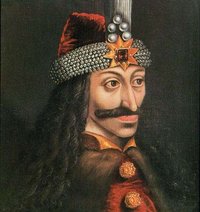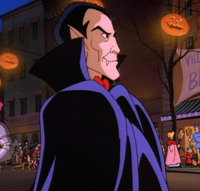Dracula
Dracula is a vampire. Greg Weisman has stated his intention to use the character in the Gargoyles Universe but we do not as of yet know how, or in what form. [1] Princess Katharine once mentioned that "vampires and weres" were vulnerable to silver, but it is not clear whether this information is accurate or whether Dracula specifically shares this vulnerability. ("Ill Met By Moonlight")
As in the real world, Dracula is a well known figure of legend and popular culture. Several characters, including Elisa Maza, have mentioned Dracula in relation to creepy places or situations. ("Awakening: Part Three", "The Mirror") Dracula is also a popular Halloween costume, with at least one person dressed as Dracula attending the Greenwich Village block party in 1995. ("Eye of the Beholder")
Real World Background
The infamous vampire was based on the even more infamous, Vlad III, prince of Wallachia. He was also known as Vlad the Impaler (Vlad Tepes in Romanian), Vlad Dracula, or just Dracula.
Born in 1431 to Vlad Dracul and Princess Cneajna of Moldavia, he had an older brother named Mircea and a younger brother named Radu the Handsome. Dracula earned his name, when, at the age of five, he was initiated into the Order of the Dragon, as his father was before him.
Under pressure from the neighboring Ottoman Empire, Vlad and Radu were given up by their father as hostages so he could continue to rule as a vassal for the Sultan. While a hostage, Vlad developed a hatred for his brother and for Mehmed, who would later become the next Sultan.
In 1447, Vlad's father was assassinated, and his brother Mircea was blinded with hot iron stakes and buried alive, allegedly under orders of Hungarian regent John Hunyadi. The Ottomans invaded Wallachia and the Sultan put Vlad III on the throne as a puppet ruler. His rule at this time would be brief; Hunyadi himself invaded Wallachia and ousted him the same year.
Vlad lived in exile with his uncle, Bogdan II, until his assassination by Petru Aron. Vlad fled to Hungary and became an adviser to Hunyadi. In 1456, Hungary invaded Serbia and drove out the Ottomans. Vlad III simultaneously invaded Wallachia with his own contingent. Both campaigns were successful, although Hunyadi died suddenly of the plague. Nevertheless, Vlad was now prince of his native land. Vlad used severe methods to restore order in Wallachia, and was constantly on guard against enemies from both outside his borders and within.
During the 1450s, Vlad allied with Hungary against the Ottoman Empire. The most important of these attacks took place on the nights of June 16–17, when Vlad and some of his men allegedly entered the main Turkish camp (wearing Ottoman disguises) and attempted to assassinate Mehmed. Unable to subdue Vlad, the Turks left the country, leaving Radu the Handsome to continue fighting. Despite Vlad achieving military victories, he had alienated himself from the nobility, which sided with Radu the Handsome. By August 1462 Radu had struck a deal with the Hungarian Crown. Consequently, Vlad was imprisoned by Matthias Corvinus.
Vlad was imprisoned from 1462 until 1466, but managed to gradually win his way back into the graces of Hungary's monarch; so much so that he was able to meet and marry a member of the royal family, Countess Ilona Szilágy (the cousin of Matthias), and have two sons who were about ten years old when he reconquered Wallachia in 1476. The openly pro-Turkish policy of Vlad's brother, Radu (who was prince of Wallachia during most of Vlad's captivity), was a probable factor in Vlad's rehabilitation. During his captivity, Vlad also converted to Catholicism, in contrast to his brother who converted to Islam.
There are several variants of Vlad III the Impaler's death. It is generally believed that he was killed by the Janissaries near Bucharest in December 1476 during the Battle of Vaslui.
Vlad left behind an infamous legacy, as stories about him and his atrocities spread far and wide across Europe. But he was truly immortalized when Bram Stoker wrote his book entitled Dracula which was published in 1897, about a powerful vampire named Count Dracula living in Transylvania. However, recent research suggests that Stoker actually knew little about the Prince of Wallachia. Some have claimed that the novel owes more to the legends about Elizabeth Báthory, a 16th century Hungarian countess who murdered hundreds of her servants, and allegedly bathed in their blood to maintain her youth. Regardless, many popular adaptations of Stoker's character combine the book with the Prince's notorious life with the notion that he was punished for his brutality with the curse of being a vampire.
His Romanian surname "Drăculea" means "Son of Dracul" and is derived from his father's title, Vlad the Dragon; the latter was a member of the Order of the Dragon created by Emperor Sigismund. The word "Dracul" means "the Devil" in modern Romanian but in Vlad's day also meant "Dragon" and derives from the Latin word "Draco", also meaning "Dragon". The suffix "Ulea" can be translated as "Son of".
See Also
- Dracula at Wikipedia, the Free Encyclopedia
- Vlad the Impaler at Wikipedia, the Free Encyclopedia
- Bram Stoker's Dracula at Wikipedia, the Free Encyclopedia

